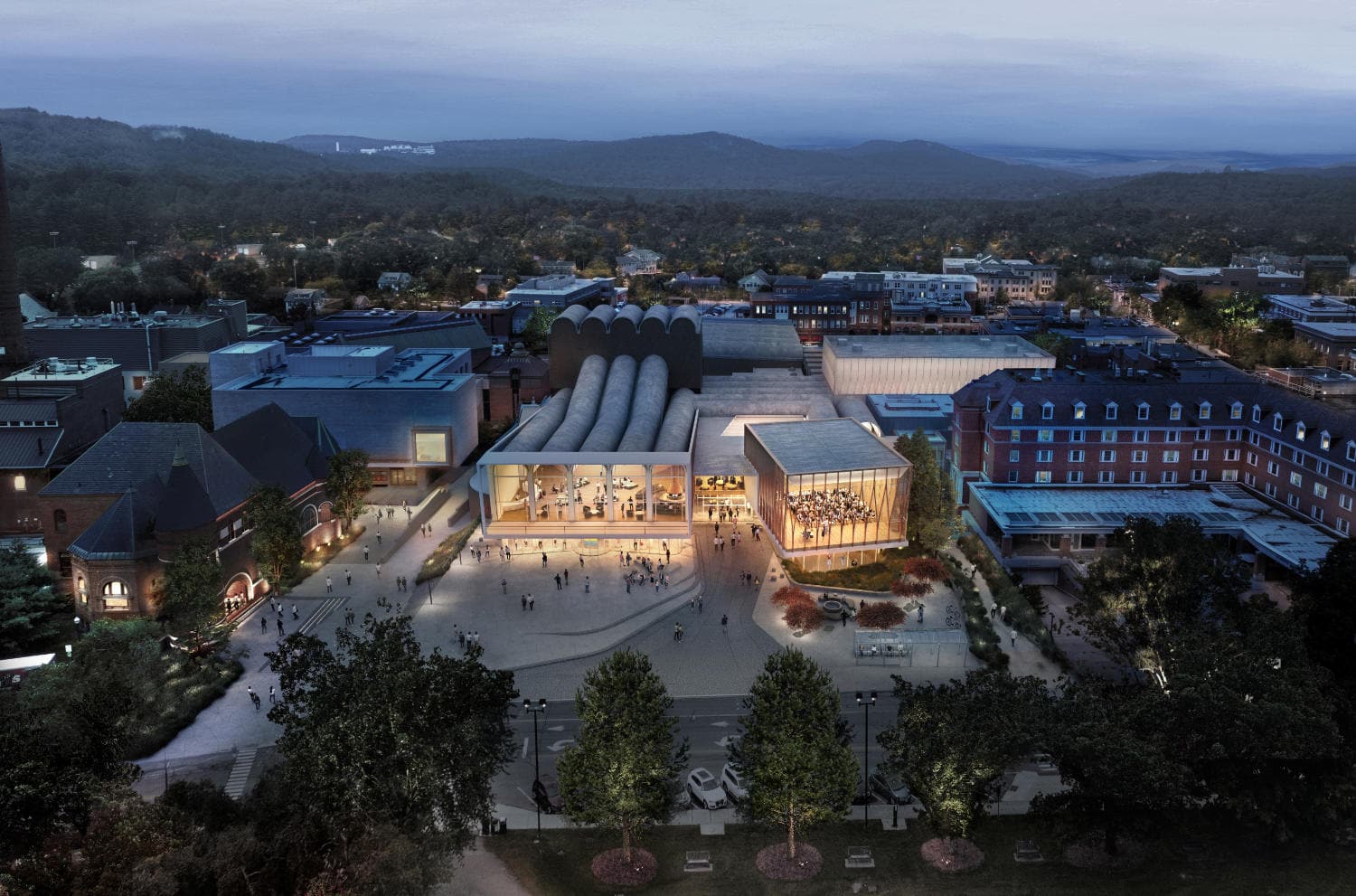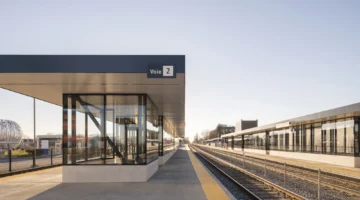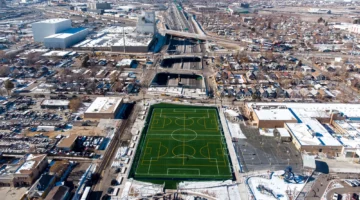Dartmouth and Snøhetta have revealed the first renderings for the forthcoming expansion and redesign of the Hopkins Center for the Arts (the Hop), a project that will create a renewed gateway to the campus’s thriving Arts District.
Designed to bring together artists and audiences, the rejuvenated and modernized Hop will build on a historic legacy of groundbreaking, interdisciplinary creativity by providing new practice and performance spaces, increased connections to surrounding arts buildings, as well as upgraded accessibility and mobility throughout the project. Along with state-of-the-art digital and broadcasting capabilities, the potential for interactive audience experiences, and increased rehearsal and production areas, the expansion will allow artists and audiences alike to create and enjoy contemporary forms of expression while complementing the Hop’s original architecture by Wallace K. Harrison.
Snøhetta’s expansion works alongside the playfully expressive existing architecture while also preserving the building’s iconic arches and presence on The Green, as well as its beloved spaces like the Top of the Hop, Moore Theatre, and Spaulding Auditorium.
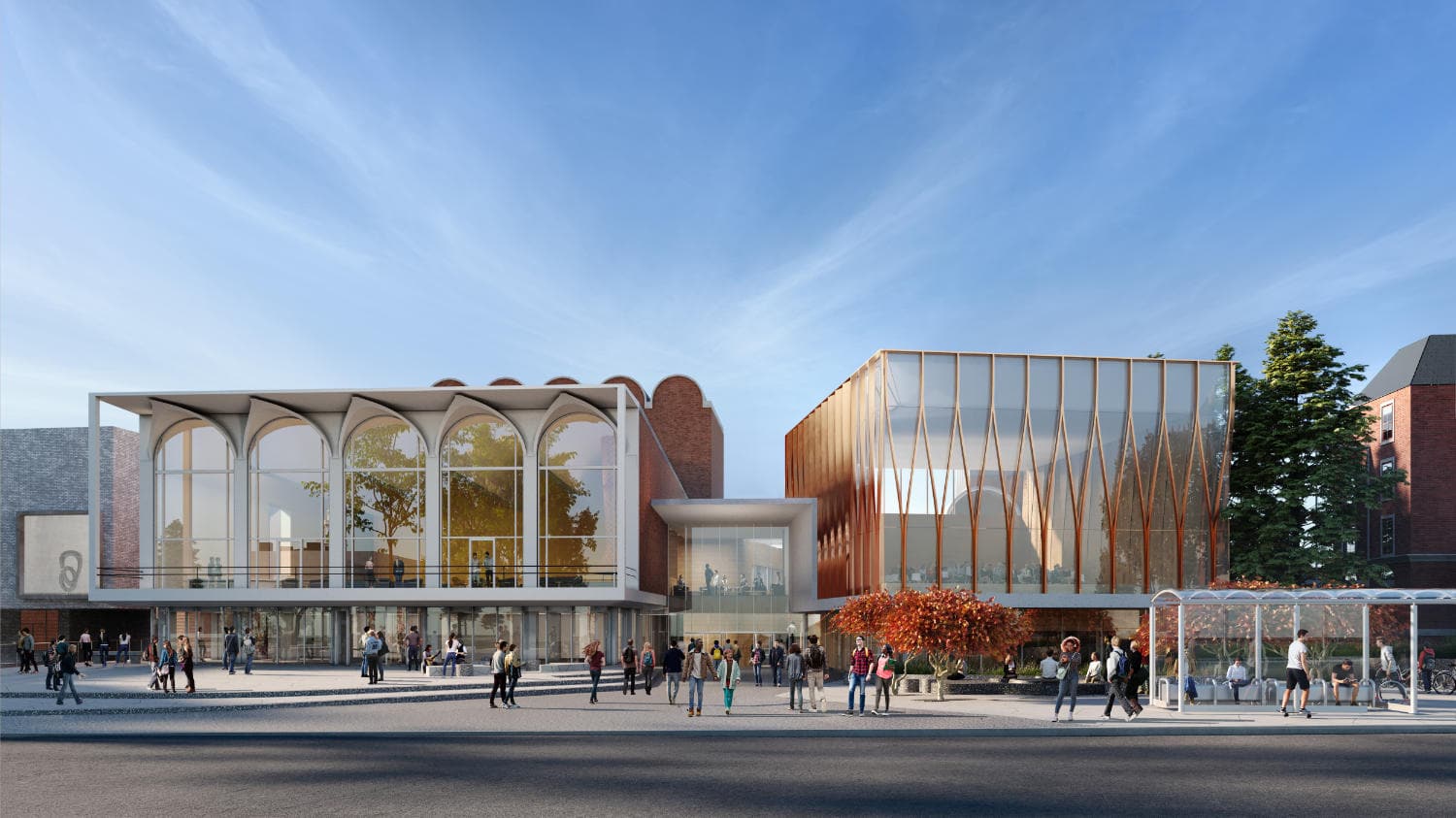
Welcome, gather, create
The Hop introduces visitors to a multifaceted arts and culture district that connects The Green at the center of campus with the town of Hanover, serving as a front door to the campus as well as a vital place of gathering for visitors, staff, and students. To extend The Hop’s welcome, the design reaches out to the adjacent streets of the campus and its surrounding New England small-town urban fabric, drawing inspiration from nearby mountains and native ecologies to celebrate its unique genius loci. The experiences of visitors, Dartmouth students, and the people of Hanover are all shaped by the region’s geography, and by its rugged natural beauty, which serves as a striking foil to the refined lawns, stately buildings, and accomplished arts practices of the campus. This combination of the rugged and refined is reflected in our design. The exterior plaza, taking inspiration from the gracious curves of the mid-twentieth century building, is sculpted for intuitive movement to guide visitors towards places for gathering, meeting, and entering. Designed as a platform to elevate the daily lives of students and faculty, the plaza welcomes visitors and offers a glimpse into the dynamism of the arts processes happening inside the building.
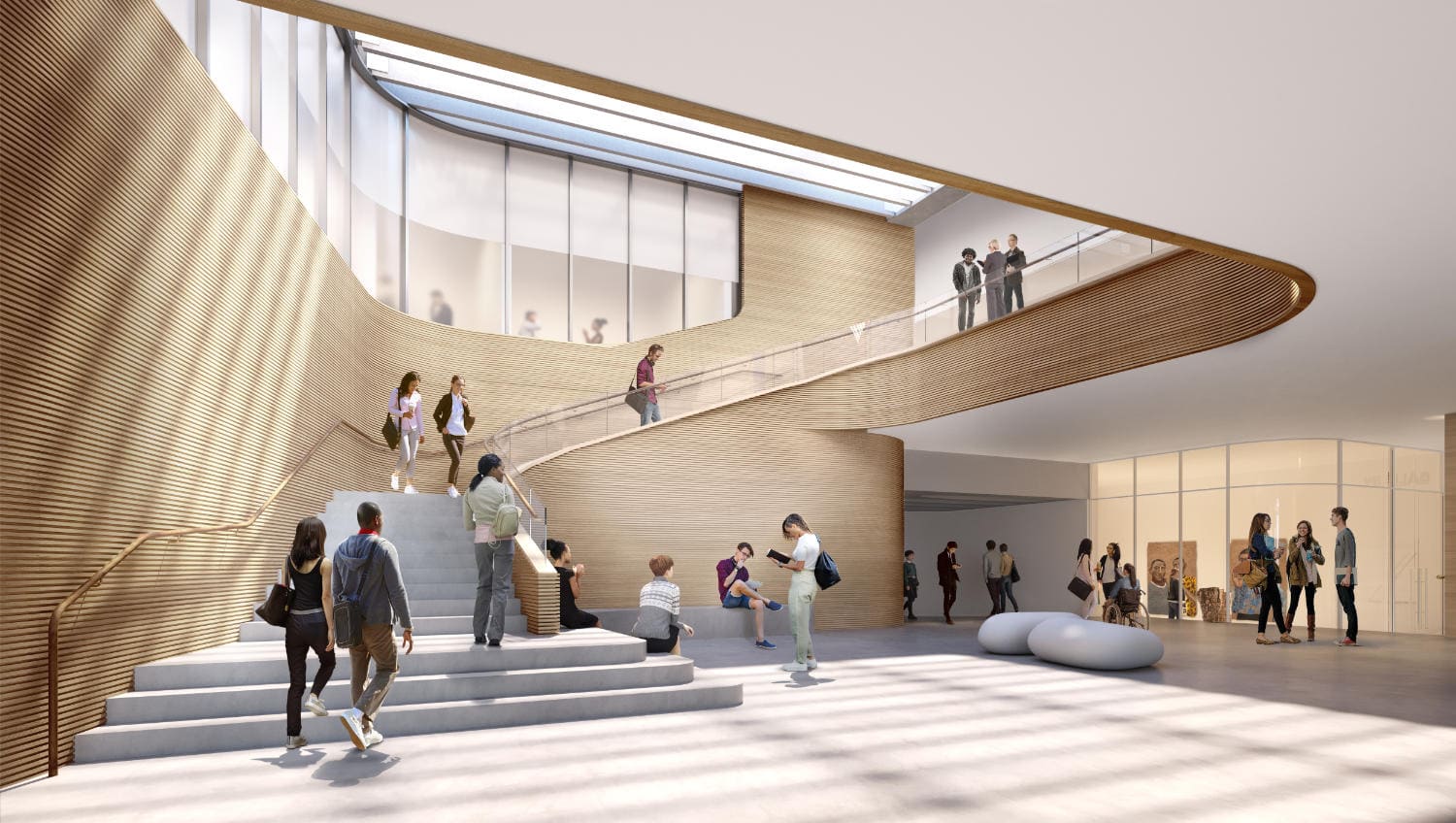
The plaza connects visitors to a new entry that expands inside the Hop to create a central meeting place linking the existing building spaces with new facilities dedicated to enriching the creative process. The new lobby, dubbed the forum, creates a vibrant social space that will be active with students, faculty, and staff throughout the day, and with audiences before and after performances. A central stair links the forum with the second-floor, connecting the new Recital Hall and a Performance Lab, two venues designed for innovative and interactive performance events, with the ground floor and plaza. The 150-seat Recital Hall is designed as a glass-enclosed lantern that overlooks the plaza and offers stunning views of the Baker Library Tower while looking into the Sugar Maples on The Green. Its tapered arch-framed windows are created using an innovative, curved mullion system, allowing for ample daylighting of the flexible seating configurations in the Hall. The space, outfitted with bespoke finishes and refined details, also offers state-of-the-art audio-visual equipment that will facilitate the creation of student-led performance media while transforming the Hop into a broadcasting center for digital performances.

A level below the forum sits the new Dance Studio, a partially-submerged rehearsal space with north-facing clerestory windows bringing in natural light and glimpses to the plaza tree canopy. As the Hop’s first purpose-built dance rehearsal space, the Studio’s 24-foot ceiling heights and well-lit interiors will offer the ideal place for dance troupes to perfect their routines. Our design also refurbishes the Hop’s 900-seat theatre, Spaulding Auditorium, while meticulously upgrading the Top of the Hop, a beloved gathering space. Several spaces on the lower level of the Hop, including the Theater Rehearsal Lab, will be reconfigured and redesigned as part of the project.
Craig Dykers, Snøhetta Founding Partner said, “The voices of an ensemble, the production team for a dance video, and audiences themselves all represent the creative potential of diverse participation. We are excited to expand the Hop's pioneering legacy as a venue for emerging forms of artistic collaboration and creative expression by bringing new rehearsal and production spaces to the building, ensuring continued support for a variety of perspectives and ways of making.”
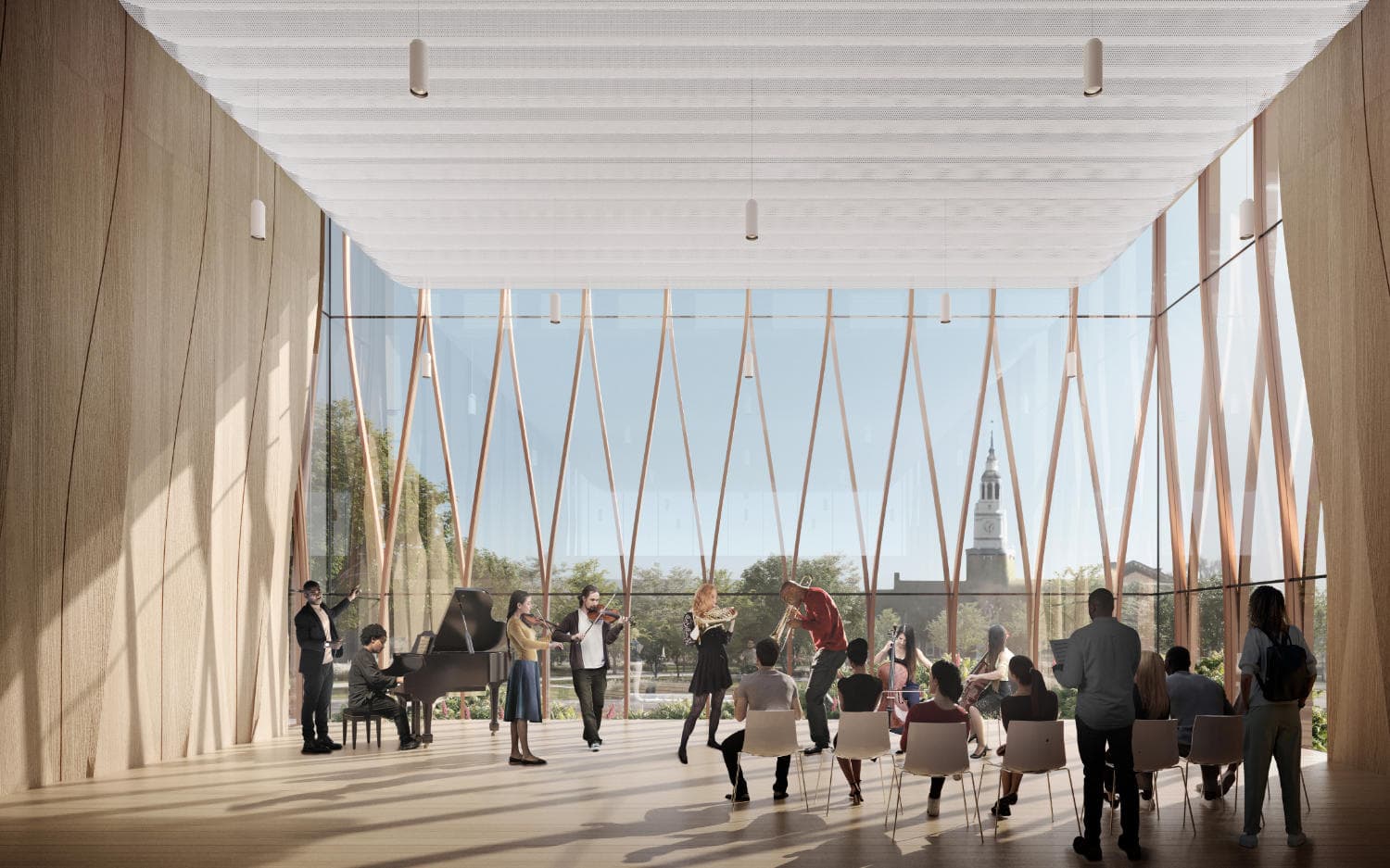
Snøhetta’s expansion of the Hop represents the latest improvement to the Dartmouth Arts District and follows the creation of the Black Family Visual Arts Center, completed in 2012 by Machado Silvetti, and the renovation of the Hood Museum of Art, redesigned by Tod Williams and Billie Tsien Architects in 2019. Construction is scheduled to begin in late 2022, and the new, transformed Hop will reopen in 2025. During the construction process, the Hop will continue to offer a range of in-person performances and programs utilizing spaces throughout the Dartmouth campus and beyond.
The expansion and modernization of the Hop is the latest performing arts venue designed by Snøhetta that envisions interdisciplinary arts collaborations as dynamic interactions between public space, performance facilities, and audiences. These projects include the Norwegian National Opera and Ballet (2008), the Wolfe Center for the Collaborative Arts at Bowling Green State University (2011), the Isabel Bader Centre for the Performing Arts at Queen's University (2014), the Moss Arts Center at Virginia Tech (2014), and the St. Louis Symphony Orchestra Powell Hall Expansion (2025).
About the Hopkins Center for the Arts
Situated on the Green at Dartmouth, the Hopkins Center serves as a hub of performing arts and film for the campus and New England region. A leader in experiential education, it is dedicated to bringing together visiting artists, resident artists, student ensembles, and academic departments to produce and present work that represents diverse voices and perspectives and engages with a wide spectrum of artistic forms and ideas. It acts as a laboratory for creative experimentation and an instigator for exploring the connections among different artistic disciplines, the Dartmouth curriculum, and the wider community.
About Dartmouth
Founded in 1769, Dartmouth is a member of the Ivy League and consistently ranks among the world’s greatest academic institutions. Dartmouth has forged a singular identity for combining its deep commitment to outstanding undergraduate liberal arts and graduate education with distinguished research and scholarship in the Arts and Sciences and its four leading graduate schools—the Geisel School of Medicine, the Guarini School of Graduate and Advanced Studies, Thayer School of Engineering, and the Tuck School of Business.
